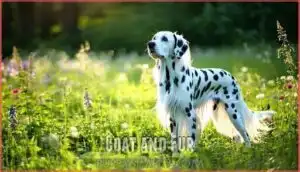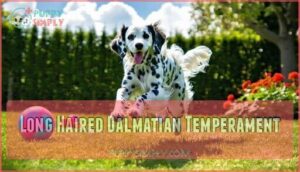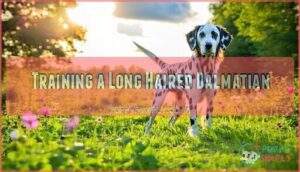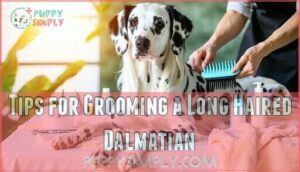This site is supported by our readers. We may earn a commission, at no cost to you, if you purchase through links.

These long-haired Dalmatians aren’t a different breed or a designer mix—they’re purebred dogs carrying a recessive gene that’s been part of the breed since its origins in Croatia’s Dalmatia region centuries ago. Despite their authentic lineage, they’ve remained relatively unknown, partly because major kennel clubs initially recognized only the short-haired variety.
If you’re drawn to these spotted beauties with their unexpected flowing coats, understanding their unique traits, grooming requirements, and care needs will help you decide if this rare variation fits your lifestyle.
Table Of Contents
- Key Takeaways
- Long Haired Dalmatian Breed History
- Long Haired Dalmatian Appearance
- Long Haired Dalmatian Temperament
- Training a Long Haired Dalmatian
- Tips for Grooming a Long Haired Dalmatian
- Long Haired Dalmatian Health Issues
- Long Haired Dalmatian Life Expectancy
- Are Long Haired Dalmatians Aggressive?
- Long Haired Dalmatians and Allergies
- Where to Find Long Haired Dalmatians
- Frequently Asked Questions (FAQs)
- What is the average lifespan of a Long Haired Dalmatian?
- What is the approximate cost of purchasing a Long Haired Dalmatian?
- Can long haired Dalmatians compete in dog shows?
- How much do long haired Dalmatians eat daily?
- Do long haired Dalmatians get along with cats?
- What climate is best for long haired Dalmatians?
- Are long haired Dalmatians good apartment dogs?
- Conclusion
Key Takeaways
- About 6% of purebred Dalmatians carry a recessive gene for long, silky fur that can reach 2-4 inches, with feathering on ears, legs, and tail—this isn’t a designer mix but an authentic breed variation that’s existed since the breed’s Croatian origins.
- Long-haired Dalmatians face significant health challenges, including 15-25% rates of congenital deafness, up to 30% susceptibility to urinary stones from excess uric acid production, and a 10-15 year lifespan that depends heavily on proactive veterinary care and weight management.
- These dogs need 60-90 minutes of vigorous daily exercise and shed year-round, requiring daily brushing with specialized tools to prevent matting in their feathered areas—they’re decidedly not hypoallergenic despite producing the same allergen proteins as short-haired Dalmatians.
- Major kennel clubs like the AKC only recognize short-coated Dalmatians for conformation shows, which has kept long-haired variants rare and lesser-known, though reputable breeders charge $1,500-$2,500 for health-tested puppies while rescue adoptions run $50-$300.
Long Haired Dalmatian Breed History
The Dalmatian breed has deep roots stretching back to Croatia’s Dalmatia region, with historical records appearing as early as the 1300s.
In 1374, a Croatian bishop documented a white, spotted hunting dog—many believe this was an early reference to what would become the Dalmatian we recognize today, including its long-haired variant.
Originally bred as hunting dogs, Dalmatians later served as coach guard dogs for European nobility. The long-coated gene appears in approximately 6% of Dalmatian puppies, a consistent population trend throughout breed history.
When these dogs migrated to England and the United States in the late 1800s, demand surged. However, the AKC recognition in 1888 included only short-haired Dalmatians. Media influence, particularly Disney’s 1961 film, boosted the breed’s popularity but overshadowed the long-haired variation.
Today, preservation efforts focus on maintaining this unique coat gene origins while ensuring the breed’s genetic health. These dogs are known for their gentle and loyal temperament, making them excellent companions.
Long Haired Dalmatian Appearance
Long-haired Dalmatians stand out with their distinctive spotted coats and athletic build, making them instantly recognizable. Their appearance shares many traits with their short-coated cousins, but the longer fur adds unique charm and grooming needs.
Here’s what their coat and size look like.
Coat and Fur
A long-haired Dalmatian’s coat stretches anywhere from 2 to 4 inches, with silky feathering that flows down the ears, tail, and legs like a natural fringe. This coat variation gives them a softer, more elegant look compared to their short-haired cousins, though the classic spotted pattern stays the same.
Their coat has a few distinctive features:
- Coat length: Fur generally measures 2-4 inches, creating that signature long coat appearance
- Fur texture: Silky and smooth to the touch, softer than the short-haired variety
- Coat color: Classic black or liver spots on white, with occasional lemon or tri-color variations
- Shedding frequency: Year-round shedding requires daily brushing with a dual soft bristle-pin brush
- Grooming needs: Regular LongHaired Dalmatian grooming prevents matting, especially around feathered areas
Expect consistent dog grooming sessions to keep their coat healthy and your home hair-free.
Size and Weight
Beyond their flowing feathers and silky coat, these purebred Dalmatians match the breed standards for size you’d expect. Adult height reaches 19 to 24 inches at the shoulder—males generally hit 22 to 24 inches, while females settle around 20 to 22 inches.
Your dog’s puppy weight will climb fast, hitting roughly half their adult size by four to six months. Growth milestones show most Dalmatians reach their full 45 to 70 pounds between 12 and 18 months, though some size variance exists. Males often outweigh females, and individual genetics can push the range slightly higher or lower. A Dalmatian’s final size is usually reached by 15 months.
Long Haired Dalmatian Temperament
Long-haired Dalmatians thrive on action—they’re not couch potatoes. These spotted athletes need 60–90 minutes of hard exercise every day to channel their impressive energy levels and stay mentally sharp.
Studies show 89% adapt beautifully to family life, forming tight bonds with everyone from toddlers to grandparents. Their sociability shines through, with 81% getting along smoothly with other dogs when introduced properly.
As a family companion, this Dalmatian breed brings protective instincts without excessive territoriality, alerting you to visitors about 69% of the time. Their trainability ranks them in the top 40 breeds for intelligence, following first commands at 65% success rates. That’s why consistent positive reinforcement works wonders with these clever dogs.
Training a Long Haired Dalmatian
Training a long-haired Dalmatian takes patience, consistency, and a good understanding of the breed’s energetic nature. These intelligent dogs respond well to positive reinforcement, but they need clear boundaries from day one.
Here are three key training areas that’ll make the biggest difference with your long-haired Dal.
Socialization With Children
Dalmatians bring incredible energy to family life, and when socialized early with children, they develop into devoted playmates who thrive on interaction.
Start puppy socialization early to shape your long-haired Dalmatian temperament into that of a gentle family companion. Supervised playdates teach age-appropriate interaction while building trust. Focus on:
- Teaching empathy through recognizing signals like tail wagging or retreat
- Child-dog safety during active play sessions
- Positive training that rewards calm behavior around kids
This foundation creates a loyal, kid-friendly dog.
Exercise Needs
Your long-haired Dalmatian needs at least 60 to 90 minutes of vigorous activity each day to stay happy and healthy. This breed’s high-energy temperament demands daily activity that challenges both body and mind. Think running, hiking, or agility training—exercise intensity matters more than duration alone. Mix in mental stimulation through puzzle toys or scent work to prevent boredom.
Consider these activity essentials:
- Puppy exercise: Start with shorter, gentler sessions to protect developing joints
- Senior exercise: Scale back intensity as your Dalmatian ages, focusing on low-impact walks
Without proper dog exercise, your long-haired Dalmatian may develop destructive behaviors or weight issues.
Health Concerns (Deafness and Obesity)
Though long-haired Dalmatians face genetic predisposition to congenital sensorineural deafness (CSD)—affecting up to 30% of the breed—and obesity, you can manage both through smart planning.
Ask breeders for BAER deafness testing results before adoption, and maintain strict diet management paired with a consistent exercise regimen.
Without proper obesity prevention, even a 10% weight gain can shorten your dog’s lifespan by years, compounding other canine health issues inherent to this spotted beauty.
Tips for Grooming a Long Haired Dalmatian
If you own a long-haired Dalmatian, you already know the shedding is relentless. Their 2-4 inch coat needs daily brushing with a soft bristle-pin combo brush—not just to keep them looking good, but to stop the hair from taking over every surface in your home.
Shedding control means brushing techniques that reach the undercoat, especially around those feathered ears and tail. For bathing frequency, aim for every 6-8 weeks with quality coat products that won’t strip natural oils. Regular long-haired Dalmatian grooming keeps mats at bay and your pup looking sharp.
- Professional grooming every few months helps manage those hard-to-reach spots and keeps the feathering neat.
Long Haired Dalmatian Health Issues
Longhaired Dalmatians carry a few genetic health risks that come bundled with those striking spotted coats.
Deafness stands out as the biggest concern—about 15-25% of puppies are born with partial or complete hearing loss due to inherited factors. Breeders can screen for this through genetic testing before mating pairs, which helps lower the odds.
Another prevalent issue is Urolithiasis, caused by excessive uric acid production, which leads to painful bladder stones in up to 30% of these dogs. Skin problems, such as Dalmatian Bronze Syndrome (DBS), result in crusty patches and hair loss, while allergies affect roughly 20% of the breed. Joint health concerns, including hip dysplasia, are observed in 10-15% of Dalmatians, and metabolic disorders like hypothyroidism require lifelong medication.
| Health Concern | Prevalence | Management |
|---|---|---|
| Congenital Sensorineural Deafness (CSD) | 15-25% | Genetic testing, early screening |
| Urinary stones | Up to 30% | Low-purine diet, surgery if needed |
| Skin conditions (DBS) | ~20% | Specialized diets, medications |
Regular vet visits and proactive care are essential to keep your spotted companion thriving despite these challenges.
Long Haired Dalmatian Life Expectancy
Dalmatians with long coats usually live between 10 and 15 years, though some reach 16 with excellent care. A 2024 UK study found an average dog lifespan of 13.2 years for the breed.
Genetic predispositions like deafness and hyperuricosuria can shorten longevity, but breeding practices that emphasize health screening help.
Lifestyle factors matter tremendously—daily exercise, best nutrition with low-purine diets, and preventative care through regular vet visits all contribute to a longer, healthier life. Managing weight is key since obesity worsens breed-specific conditions.
With dedicated dog health management, your LongHaired Dalmatian can thrive well into their teens.
Are Long Haired Dalmatians Aggressive?
Here’s the good news—breed bite risk studies consistently show that Dalmatians, including Long-Haired Dalmatian temperament varieties, rank well below breeds like Rottweilers or German Shepherds for aggression. They’re not inherently aggressive pets.
However, dog behavior isn’t just about genetics. Up to 30% of Dalmatians have congenital deafness, and that deafness link can increase startle reactions or defensive responses if they can’t hear you approaching.
That’s why socialization importance can’t be overstated. Expose your pup to different people, dogs, and environments between 3 and 12 weeks old. Skip harsh training methods—they backfire. Positive reinforcement works best.
Exercise impact matters too; without enough daily activity, anxiety builds, and that’s when dog socialization skills slip. With consistent training and at least an hour of exercise daily, your Long-Haired Dalmatian as a pet will be playful, loyal, and far from aggressive.
Long Haired Dalmatians and Allergies
Thinking about bringing a Longhaired Dalmatian home but worried about your allergies? Here’s what you need to know: no dog is completely hypoallergenic.
These spotted dogs—like all breeds—produce allergen proteins such as Can f1 and Can f2 in their dander and saliva, which trigger reactions far more than the fur itself.
Shedding patterns don’t help either. Long-haired Dalmatians shed year-round, spreading dander across your furniture, floors, and even into the air you breathe. Over 35% of dog-allergic folks experience respiratory symptoms like sneezing and itchy eyes around Dalmatians, while about 22% develop skin reactions like hives.
But don’t write them off yet. Mitigation strategies work: bathe your dog every 4-6 weeks to cut allergen levels by up to 60%, brush several times weekly, and run a HEPA air purifier to reduce airborne dander by half. Medical interventions like antihistamines or allergen immunotherapy can also help manage human symptoms effectively.
Where to Find Long Haired Dalmatians
Your search for long-haired Dalmatian puppies starts with breeder reputation and rescue options. Reputable Dalmatian breeders like Paradise Spots Dalmatians, Hidden Hills Dalmatians in Oregon, and Missouri Dalmatians produce health-tested long-haired puppies, generally priced between $1,500 and $2,500. Regional availability varies—western states run $1,000–$3,000, while midwest prices dip to $800–$2,500.
Avoid puppy mills by verifying health testing documentation. Rescue organizations like Save the Dalmatians & Others Canine Rescue and Dalmatian Rescue of Southern California offer adoption costs from $50–$300, making them budget-friendly alternatives.
Social media groups and Dalmatian breeder recommendations can connect you with ethical sources. Finding long-haired Dalmatian breeders takes patience, but it’s worth it.
Frequently Asked Questions (FAQs)
What is the average lifespan of a Long Haired Dalmatian?
A playful spotted pup racing around your yard could be your faithful friend for 10 years or more.
With proper care, your Long Haired Dalmatian usually lives 10 to 15 years, bringing devotion and joy throughout their lifespan.
Genetic health, diet, exercise, and veterinary care all influence longevity in Longhaired Dalmatians.
What is the approximate cost of purchasing a Long Haired Dalmatian?
Longhaired Dalmatian puppy prices generally range from $600 to $1,200, depending on breeder reputation and lineage.
Initial expenses—including food, toys, bedding, and vet care—can add another $620 to $3,150, so budget for long-term costs beyond adoption fees.
Can long haired Dalmatians compete in dog shows?
The old saying might warn against judging books by covers, but the American Kennel Club (AKC) and United Kennel Club (UKC) take issue with longhaired Dalmatians all the same.
Because breed standards specify short coats, long-haired variations face coat disqualifications, making them ineligible for conformation shows despite their striking appearance.
How much do long haired Dalmatians eat daily?
Adult Dalmatians usually need 2 to 3 cups of quality dog food daily, split between meals, while puppy feeding requires more frequent portions for growth.
Calorie requirements vary based on weight management needs—active dogs burn more, seniors less.
Dietary needs depend on age, activity level, and overall dog health.
Do long haired Dalmatians get along with cats?
Your Dalmatian’s success with cats depends on early socialization and proper cat introduction tips.
With patience and consistent dog training, most Longhaired Dalmatians can learn feline-canine harmony, though their high energy requires careful supervision in multi-pet homes.
What climate is best for long haired Dalmatians?
Temperate zones work best for these spotted pups, since moderate temperatures keep them comfortable year-round.
Cold climates can be tough on their lean build, while humid regions may aggravate health issues and complicate grooming needs.
Are long haired Dalmatians good apartment dogs?
You might think apartment living suits these spotted beauties, but long-haired Dalmatians need substantial space for their high energy levels.
Their exercise demands, potential noise from barking, and shedding make small spaces challenging without daily outdoor activity.
Conclusion
There’s something striking about watching those flowing spotted coats catch the morning sunlight on your daily walk—it’s one of the simple pleasures that come with owning a long-haired Dalmatian.
These rare beauties demand commitment through extra grooming sessions and vigilant health monitoring, but they reward you with the same spirited personality that’s defined the breed for centuries.
If you’re prepared to embrace both the stunning aesthetics and the hands-on care requirements, you’ll discover a loyal companion who turns heads wherever spotted paws travel.
- https://articles.hepper.com/long-haired-dalmatian/
- https://pmc.ncbi.nlm.nih.gov/articles/PMC7371805/
- https://wildearth.com/blogs/dog-knowledge/long-haired-dalmatian
- https://www.petmd.com/dog/breeds/dalmatian
- https://www.berkeleyobserver.com/2018/03/18/goose-creek-dalmatian-dies-at-the-surprising-age-of-20-years-old/
















